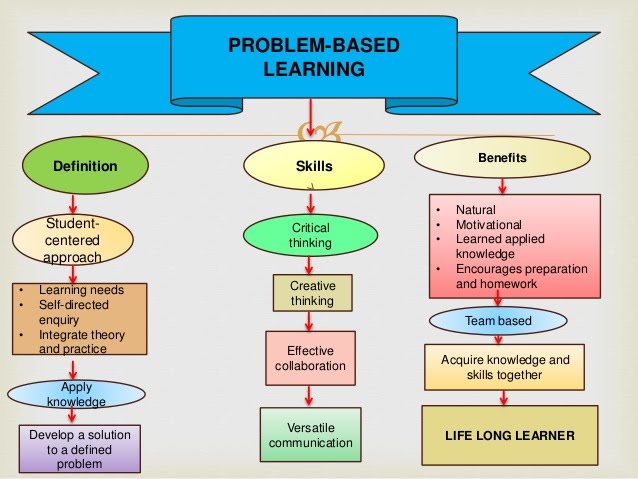In problem-based learning, students are given a practical or real challenging problem, such as a case study or hypothetical circumstance, and utilize inductive reasoning to gain knowledge of the subject and develop critical thinking skills.
In addition to course content, Problem-Based Learning (PBL) can promote the development of critical thinking skills, problem-solving abilities, and communication skills.
It can also provide opportunities for working in groups, finding and evaluating research materials, and life-long learning (Duch et al, 2001).
Read Also: Bloom Taxonomy Levels with Example, Pyramid, and Chart
It fosters self-directed learning by studying complicated, open-ended topics where the instructors facilitate and guide rather than educate, as opposed to passively listening to lectures or even being guided through the Socratic method of teaching through questions and answers.
PBL can be applied to any field as a long-term or short-term project. It was initially created as a semester-long project for medical students.
Problem-based learning (PBL) is an example of active learning that will motivate students to reflect carefully and assume ownership of their education.

Image source: Slideshare
Problem-based learning environment
PBL can be used for any subject with a bit of imagination. There are some qualities of good PBL problems that cut across disciplines, even though the fundamental issues will vary by discipline (Duch, Groh, and Allen, 2001):
- Students must be inspired by the issue to seek out a deeper comprehension of the ideas.
- Students should be challenged to reason through their decisions and defend them.
- The challenge should incorporate the learning objectives in a way that links them to prior learning.
- If used for a group project, the issue must be complex enough to require cooperation from the pupils.
- If used for a multistage project, the initial steps of the problem should be open-ended and engaging to draw students into the problem
Problem-Based Learning Examples
- In Philosophy, the students are divided into small groups and instructed to examine a complex moral dilemma from the perspective of a different philosopher they have studied. The example is taken from a news article. The philosophy lecturer finds it.
- In product development, the design professor course has student teams create product packaging that complies with rigorous environmental standards.
- An instructor in clinical medicine gives a fictitious case study to the class. Students will determine the patient’s diagnosis, pick a course of action, and justify their decision.
- At the beginning and end of each unit, an urban planning instructor assigns each group a city with a variety of difficulties and asks them to investigate the causes of each issue. Each group submits a report with suggestions for resolving the problems at the end of the semester.
What are the principles of problem-based learning?
Slavery and Duffy (1995) suggested the following principles of PBL:
- Anchor all learning activities to a larger task or problem.
- Support the learner in developing ownership for the overall problem or task.
- Design an authentic task.
- Design the task and the learning environment to reflect the complexity of the environment they should be able to function in at the end of learning.
- Give the learner ownership of the process used to develop a solution.
- Design the learning environment to support and challenge the learner’s thinking.
- Encourage testing ideas against alternative views and alternative contexts.
- Provide opportunity and support for reflection on both the content learned and the learning process.
Source: instructionaldesign.com.au
What are the advantages of project-based learning?
- It aids in the development of long-term memory retention in students.
- Continuous involvement is encouraged through problem-based learning: By providing a change of pace from routine courses and exercises, problem-based learning is one of the simplest ways to keep kids interested.
- PBL aids students in acquiring practical abilities: Students can learn skills that they can apply to situations in the real world with the aid of problem-based learning. The globe is expanding quickly, therefore having in-demand talents is essential if you want to stay relevant. Early support in the development of these abilities will better equip young children for the future. For instance, if kids cooperate to give solutions to a challenge at school, they could learn how to negotiate and communicate effectively.
- Students who use problem-based learning are better able to collaborate and interact with others.
- Students learn what it takes and how to learn because this technique is centered on them.
- Because kids are just paying attention to what is necessary, it promotes specificity in learning.
- PBL encourages students to see issues and be prepared to offer solutions when called for.
What are the steps in problem-based learning?
1. Develop a problem
2. Activate existing knowledge
3. Identify the required knowledge
4. Research
5. Assess
6. Share solutions
7. Reflect and compare
8. Critically analyze
REFERENCES AND ADDITIONAL RESOURCES
Ali, S. S. (2019). Problem based learning: A student-centered approach. English language teaching, 12(5), 73-78.
Duch, B. J., Groh, S. E, & Allen, D. E. (Eds.). (2001). The power of problem-based learning. Sterling, VA: Stylus.
Barrows and Tamblyn, 1980. “Problem-Based Learning: An Approach to Medical Education.” pp. 191–192
